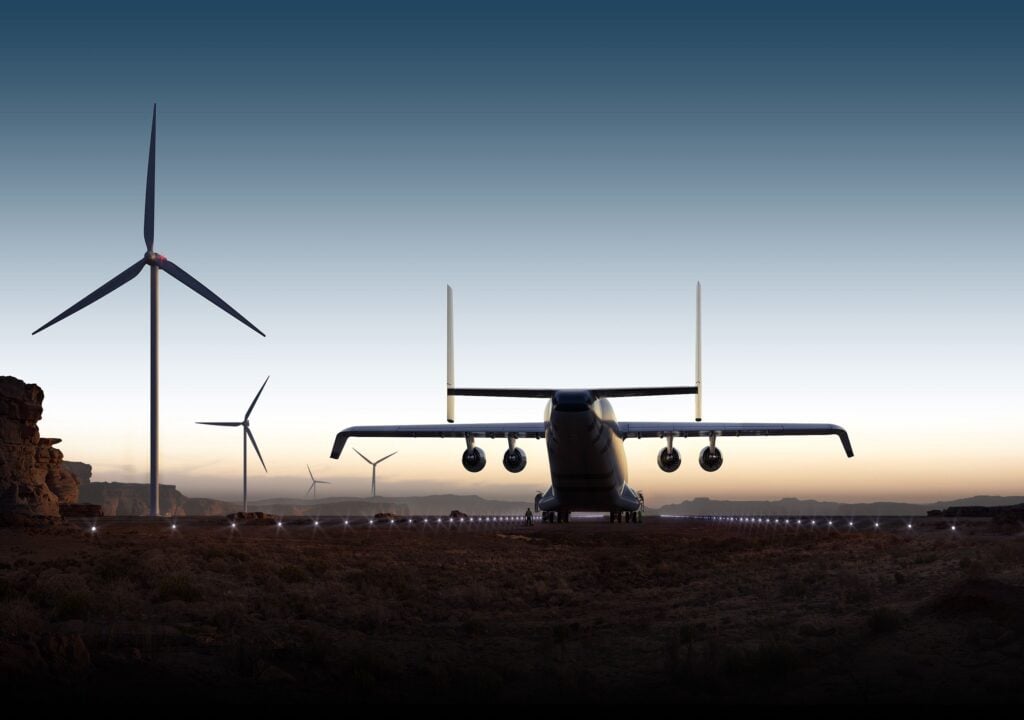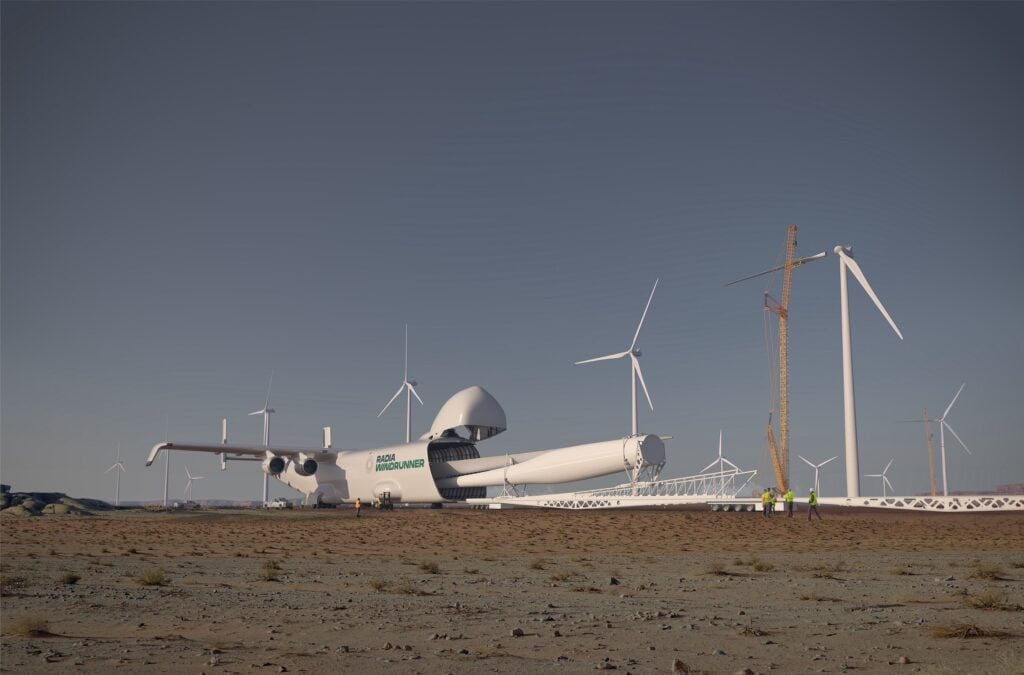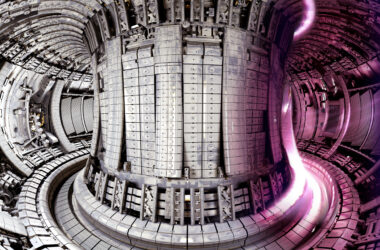Aviation startup Radia is developing the WindRunner—the world’s largest cargo plane.
The plane is designed to transport Radia’s massive wind turbine components. This groundbreaking aircraft aims to overcome the logistical barriers that have hindered the deployment of next-generation turbines in optimal onshore locations.
The Challenge of Transporting Giant Wind Turbines
As wind turbines continue to grow in size to harness more energy, the logistics of transporting their enormous components have become increasingly complex. Roads and infrastructure often need modification to accommodate blades spanning 70 meters (230 feet), while future designs are expected to surpass 100 meters (330 feet).

This limitation has hindered the expansion of wind energy projects in remote areas where the most promising resources often lie.
To overcome these obstacles, Radia has engineered the WindRunner—a behemoth tailored explicitly for the wind industry.
At 108 meters (356 feet) long and 80 meters (261 feet) wide, the WindRunner dwarfs even the iconic Boeing 747. Its immense cargo bay can accommodate payloads up to 105 meters long, 7.3 meters wide, and 7.3 meters tall, providing capacity for the giant turbine blades.
The WindRunner’s capabilities extend beyond sheer size. It features a specialised loading and unloading system that allows blades to be efficiently manoeuvred through the aircraft’s nose cargo door. This innovative design streamlines operations at wind farm sites, minimising ground time.
The plane can operate from semi-prepared airstrips as short as 1,800 meters (6,000 feet), granting access to remote locations that other large cargo aircraft cannot reach.
The Engineering Behind the WindRunner
At the heart of the WindRunner is cutting-edge aerospace engineering. This purpose-built cargo plane is designed to transport the world’s giant wind turbine blades and pushes the boundaries of size, performance, and versatility.
The WindRunner’s cargo bay is the centrepiece of its design. Measuring an astonishing 105 meters (344 feet) in length, 7.3 meters (24 feet) in width, and 7.3 meters (24 feet) in height, it provides ample space to accommodate the most extended turbine blades in production.
The aircraft’s unique dimensions—108 meters (356 feet) and a wingspan of 80 meters (261 feet)—surpass even the most significant commercial airliners.




Radia’s engineers have developed a specialised cargo handling system to ensure the safe and efficient loading and unloading of these colossal payloads. The WindRunner features a large nose cargo door that allows blades to be easily maneuvered in and out of the aircraft. This innovative design, coupled with a custom-built loading mechanism, streamlines the process of transporting turbine components, minimising ground time and maximising efficiency.
The WindRunner’s performance capabilities are equally impressive. Powered by advanced, fuel-efficient engines, the aircraft can reach cruise speeds of up to Mach 0.6 (approximately 740 km/h or 460 mph) while carrying payloads of up to 72,575 kg (160,000 lbs). This speed and payload capacity combination enables the WindRunner to deliver turbine blades to remote locations quickly and cost-effectively.
Another critical aspect of WindRunner’s engineering is its ability to operate from relatively short and undeveloped airstrips. The aircraft’s robust landing gear and advanced navigation systems allow it to land and take off from semi-prepared runways as short as 1,800 meters (6,000 feet). This unique capability opens up a wide range of potential wind farm sites previously inaccessible to large cargo planes, significantly expanding the reach of onshore wind energy development.
Radia has conducted extensive testing and simulations to validate WindRunner’s groundbreaking design. Scale models of the aircraft have undergone rigorous wind tunnel testing to optimise their aerodynamic performance and ensure structural integrity. The company claims these tests have confirmed the WindRunner’s ability to operate safely and efficiently when transporting oversized wind turbine components.
As Radia moves forward with the production of the WindRunner, the company is collaborating closely with leading aerospace manufacturers and suppliers to bring this engineering marvel to life. The company hopes to ensure that the WindRunner will set a new standard for specialised cargo aircraft by leveraging cutting-edge materials, advanced manufacturing techniques, and state-of-the-art avionics.
WindRunner’s engineering could represent a significant leap forward in aerospace design and renewable energy logistics if the design gets off the ground.
Enabling Deployment of Cutting-Edge Turbines
Radia’s WindRunner will be instrumental in installing the company’s GigaWind onshore turbines. These massive machines, equipped with blades exceeding 100 meters in length, promise to considerably increase energy output while reducing the overall cost of wind power.

With the final design complete, the next step is to bring the WindRunner from concept to reality. Scale model testing in wind tunnels has validated the aircraft’s aerodynamic performance, and the company is actively engaging with factories and suppliers to lay the groundwork for production.

Commercial operations are slated to commence by the end of 2027. Radia has already secured a contract to deliver turbines to a gigawatt-scale wind farm.
As the world increasingly turns to cleaner energy sources, innovative engineering solutions like the WindRunner will be vital in overcoming the challenges that lie ahead. The colossal cargo plane could be key to unlocking the vast potential for onshore wind power generation by bridging the gap between wind turbine manufacturing and installation.
We hope that the WindRunner is a success; on paper, it promises to be a game-changing aircraft that embodies the spirit of innovation and the urgency of the global transition to clean energy. However, we retain some healthy scepticism until we see this colossal cargo plane take to the skies; it can reshape the wind energy landscape, making onshore wind power more accessible, efficient, and cost-effective than ever before.
TLDR:
- Radia’s WindRunner, the world’s largest cargo plane, is designed to transport massive wind turbine components to remote onshore locations.
- With its unparalleled size and specialised features, the WindRunner will enable the deployment of next-generation wind turbines, increasing output and reducing costs.
- The aircraft’s ability to operate from shorter airstrips opens up new opportunities for wind farm development in previously inaccessible areas.
- Radia aims to commence commercial operations by late 2027, having secured a contract with a large-scale wind farm.
- The WindRunner represents a significant step forward in the global transition to clean energy. It combines innovative engineering with a commitment to sustainability.







